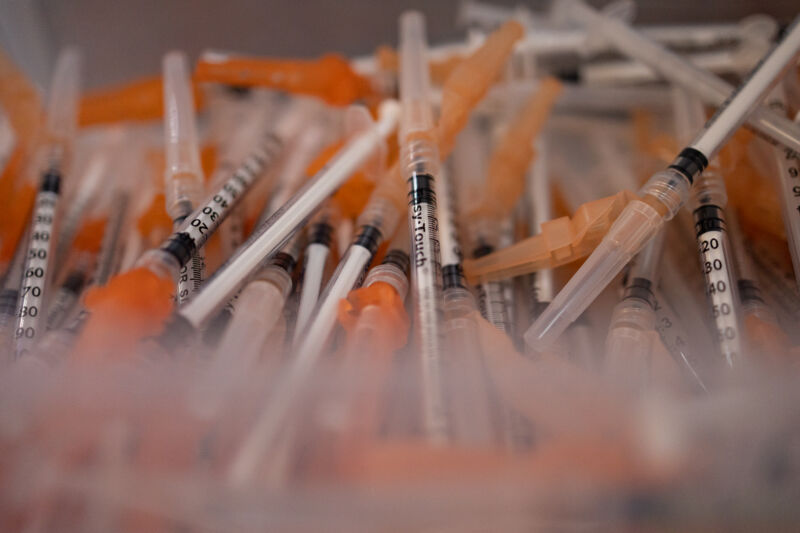-
 chevron_right
chevron_right
Didier Raoult mis au pilori par plusieurs grands journaux scientifiques
news.movim.eu / JournalDuGeek · Friday, 5 April - 15:57

 chevron_right
chevron_right
Didier Raoult mis au pilori par plusieurs grands journaux scientifiques
news.movim.eu / JournalDuGeek · Friday, 5 April - 15:57

 chevron_right
chevron_right
101 studies flagged as bogus COVID cure pusher sees career unravel
news.movim.eu / ArsTechnica · Thursday, 4 April - 17:05

Enlarge / Microbiologist Didier Raoult addresses a press conference on COVID-19 at the IHU medical institute in Marseille on April 20, 2022. (credit: Getty | )
A scientific journal published by Elsevier has reportedly posted a stunning 101 expressions of concern on studies connected to Didier Raoult, a disgraced French microbiologist who gained international prominence amid the pandemic by promoting, with little evidence, that the malaria drug hydroxychloroquine could treat COVID-19— a claim that has now been firmly debunked .
According to Retraction Watch , the journal New Microbes and New Infections posted 101 expressions of concern on Raoult's works recently, including a 2023 study that drew sharp criticism. The study involved giving hydroxychloroquine to tens of thousands of COVID-19 patients after data indicated that it wasn't effective and the French government rescinded permission for its use against COVID-19. An op-ed in the major French newspaper Le Monde described the study as " the largest 'wild' therapeutic trial known to date ."
The expressions of concern also come as Raoult saw his tenth study retracted, Retraction Watch noted.
 chevron_right
chevron_right
Un homme s’est fait vacciner 217 fois contre le Covid
news.movim.eu / JournalDuGeek · Thursday, 7 March - 16:14

 chevron_right
chevron_right
German man got 217 COVID shots over 29 months—here’s how it went
news.movim.eu / ArsTechnica · Tuesday, 5 March - 19:40

A 62-year-old man in Germany decided to get 217 COVID-19 vaccinations over the course of 29 months —for "private reasons." But, somewhat surprisingly, he doesn't seem to have suffered any ill effects from the excessive immunization, particularly weaker immune responses, according to a newly published case study in The Lancet Infectious Diseases .
The case is just one person, of course, so the findings can't be extrapolated to the general population. But, they conflict with a widely held concern among researchers that such overexposure to vaccination could lead to weaker immune responses. Some experts have raised this concern in discussions over how frequently people should get COVID-19 booster doses.
In cases of chronic exposure to a disease-causing germ, "there is an indication that certain types of immune cells, known as T-cells, then become fatigued, leading to them releasing fewer pro-inflammatory messenger substances," according to co-lead study author Kilian Schober from the Institute of Microbiology – Clinical Microbiology, Immunology and Hygiene. This, along with other effects, can lead to "immune tolerance" that leads to weaker responses that are less effective at fighting off a pathogen, Schober explained in a news release.
 chevron_right
chevron_right
La Covid-19 vous a surement rendu plus bête, c’est la science qui le dit
news.movim.eu / JournalDuGeek · Tuesday, 5 March - 09:34

 chevron_right
chevron_right
COVID is a lot like the flu now, CDC argues in new guidance
news.movim.eu / ArsTechnica · Saturday, 2 March - 00:16

Enlarge / A view of the Centers for Disease Control and Prevention headquarters in Atlanta. (credit: Getty | Nathan Posner )
COVID-19 is becoming more like the flu and, as such, no longer requires its own virus-specific health rules, the Centers for Disease Control and Prevention said Friday alongside the release of a unified " respiratory virus guide ."
In a lengthy background document , the agency laid out its rationale for consolidating COVID-19 guidance into general guidance for respiratory viruses—including influenza, RSV, adenoviruses, rhinoviruses, enteroviruses, and others, though specifically not measles. The agency also noted the guidance does not apply to health care settings and outbreak scenarios.
"COVID-19 remains an important public health threat, but it is no longer the emergency that it once was, and its health impacts increasingly resemble those of other respiratory viral illnesses, including influenza and RSV," the agency wrote.
 chevron_right
chevron_right
CDC recommends spring COVID booster for people 65 and up
news.movim.eu / ArsTechnica · Wednesday, 28 February - 23:10

Enlarge / The Moderna Spikevax COVID-19 vaccine is shown at a CVS in 2023. (credit: Getty | Melissa Phillip/Houston Chronicle )
People ages 65 and up should get another dose of a COVID-19 vaccine this spring, given the age group's higher risk of severe disease and death from the pandemic virus, the Centers for Disease Control and Prevention announced Wednesday.
Earlier today, an advisory committee for the CDC voted overwhelmingly in favor of recommending the spring booster dose. And late this afternoon, CDC Director Mandy Cohen signed off on the recommendation, allowing boosting to begin.
"Today’s recommendation allows older adults to receive an additional dose of this season’s COVID-19 vaccine to provide added protection," Cohen said in a statement. "Most COVID-19 deaths and hospitalizations last year were among people 65 years and older. An additional vaccine dose can provide added protection that may have decreased over time for those at highest risk."
 chevron_right
chevron_right
RTO doesn’t improve company value, but does make employees miserable: Study
news.movim.eu / ArsTechnica · Friday, 23 February - 23:05 · 3 visibility

Enlarge / Empty cubicles
For some, having to work from home during the COVID-19 pandemic was stressful. Parents balanced job duties while caring for children. Some struggled to set up a home office and adjust to new tools, like video conferencing. Lonely workdays at home added to social isolation. The line between work and life blurred.
For others, working from home was a boon—comfort, convenience, flexibility, no commuting or rush-hour traffic, no office-environment distractions. When the acute aspects of the pandemic receded, some who at first struggled began to settle into a work-from-home (WFH) groove and appreciated the newfound flexibility.
Then, bosses began calling their employees back to the office. Many made the argument that the return-to-office (RTO) policies and mandates were better for their companies; workers are more productive at the office, and face-to-face interactions promote collaboration, many suggested. But there's little data to support that argument. Pandemic-era productivity is tricky to interpret, given that the crisis disrupted every aspect of life. Research from before the pandemic generally suggested remote work improves worker performance—though it often included workers who volunteered to WFH, potentially biasing the finding.
 chevron_right
chevron_right
First state-level look at long COVID reveals the seven hardest-hit states
news.movim.eu / ArsTechnica · Thursday, 15 February - 19:29 · 1 minute

Enlarge / A woman with Long COVID who is completely bedridden, requiring the use of a wheelchair to move between rooms of her home. (credit: Getty | Rhiannon Adam )
Over four years after SARS-CoV-2's debut, researchers still struggle to understand long COVID, including the ostensibly simple question of how many people have it. Estimates for its prevalence vary widely, based on different study methods and definitions of the condition. Now, for the first time, the Centers for Disease Control and Prevention has attempted to estimate its prevalence among adults in each US state and territory. The results again show a wide range of prevalence estimates while revealing the states that were hardest hit as well as those that seem relatively spared.
Overall, the CDC found that seven states in the South, West, and Midwest had the highest prevalence of long COVID in the country, between 8.9 percent and 10.6 percent: Alabama, Montana, North Dakota, Oklahoma, Tennessee, Wyoming, and, the state with the highest prevalence of 10.6 percent, West Virginia. The results are published today in the CDC's Morbidity and Mortality Weekly Report .
On the other end of the spectrum, New England states, Washington, and Oregon had lower prevalence rates, between 3.7 percent and 5.3 percent. The lowest rate was seen in the US Virgin Islands with 1.9 percent. Washington, DC, and Guam had ranges between 1.9 percent and 3.6 percent.